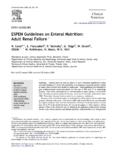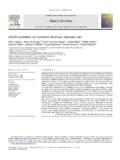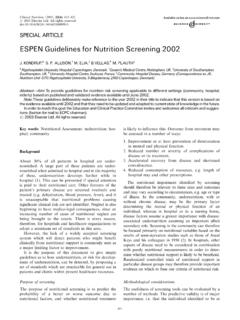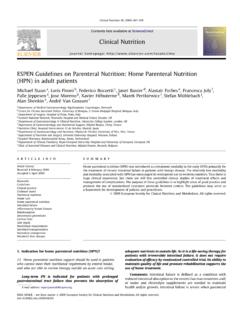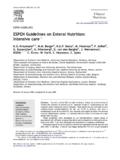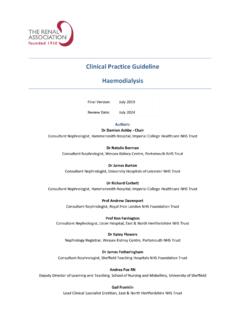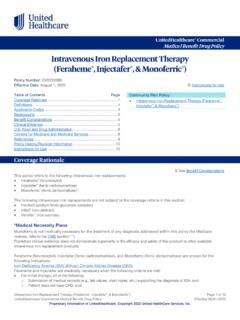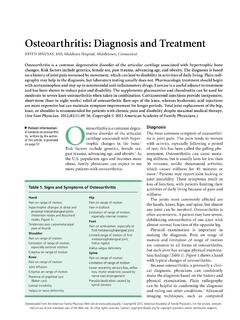Transcription of ESPEN Guidelines on Parenteral Nutrition: Adult Renal Failure
1 ESPEN Guidelines on Parenteral Nutrition: Adult Renal Canoa,b,c, M. Apariciod, G. Brunorie, Carrerof, B. Cianciarusog, E. Fiaccadorih, B. Lindholmf,V. Teplani, D. Fouquej, G. GuarnierikaCRNH Auvergne, F-63009, Clermont-Ferrand, FrancebCHU Clermont-Ferrand, Service de Nutrition, Ho pital G Montpied, F-63003 Clermont-Ferrand, FrancecUniversity ersite Clermont1, Faculte de Me decine F-63001, FrancedUniversite Bordeaux II, Bordeaux, FranceeChair and Division of Nephrology, University and Spedali Civili, Brescia, ItalyfDivisions of Renal Medicine and Baxter Novum, CLINTEC, Karolinska Institutet, Stockholm, SwedengDivision of Nephrology, School of Medicine, University Federico II of Naples, Via Pansini N 5, Naples, ItalyhInternal Medicine and Nephrology Department, Parma University Medical School, Parma, ItalyiDepartment of Nephrology, Transplant Center, Institute for Clinical and Experimental Medicine.
2 Prague, Czech RepublicjDepartment of Nephrology, INSERM U870, Univ Lyon 1, F-69003 Ho pital E. Herriot, Lyon, FrancekDivision of Internal Medicine, Department , Postgraduate Schools of Internal Medicine and Cardiology, University of Trieste, Trieste, Italyarticle infoArticle history:Received 4 February 2009 Accepted 11 May 2009 Keywords: Parenteral nutritionIntradialytic Parenteral nutritionIDPNA cute Renal failureChronic failureDialysisCAPDM alnutritionCRRT summaryAmong patients with Renal Failure , those with ARF and critical illness represent by far the largest groupundergoing artificial nutrition. ARF, especially in the ICU, seldom occurs as isolated organ Failure butrather is a component of a much more complex metabolic environment, in the setting of the multipleorgan Failure .
3 Nutritional programs for ARF patients must consider not only the metabolic derangementspeculiar to Renal Failure and with the underlying disease process/associated complications, but also therelevant derangements in nutrient balance due to Renal replacement therapies , especially when highlyefficient Renal replacement therapies (RRT) are used, such as continuous veno-venous hemofiltration(CVVH), or prolonged intermittent modalities such as sustained low-efficiency dialysis (SLED). Finally it isto be taken into account that nutrient requirements can change considerably during the course of illnessitself (see also Guidelines on PN in intensive care).From a metabolic point of view, patients with CKD or on chronic HD who develop a superimposedacute illness should be considered to be similar to patients with ARF.
4 The same principles in respect of PNshould therefore be applied. 2009 European Society for Clinical Nutrition and Metabolism. All rights of statements: Nephrology concernSubjectRecommendationsGrade NumberAcute renalfailureARF not only affects water, electrolyte and acid base metabolism but also induces global changes in the milieu interieur , withspecific alterations in protein, amino acid, carbohydrate and lipid metabolisms. Additionally, it exerts a pro-inflammatory reactionand has a profound effect on the anti-oxidative system. ARF, especially in the ICU setting, rarely represents an isolated disease changes in these patients are also determined by the underlying disease and/or co-morbidities, by other organ dysfunction,as well as by the modality and intensity of Renal replacement therapy (RRT).
5 B1 Renal replacement therapies have profound effects on metabolism and nutrient nutritional status is a major risk factor for morbidity and mortality, thus determining (continued on next page)Abbreviations:ARF, Acute Renal Failure ; CAPD, Continuous ambulatory peritoneal dialysis; CKD, Chronic Renal Failure ; CRRT, Continuous Renal replacement therapy; HD, lists available atScienceDirectClinical Nutritionjournal homepage: $ see front matter 2009 European Society for Clinical Nutrition and Metabolism. All rights Nutrition 28 (2009) 401 414 Summary of statements: Nephrology concernSubjectRecommendationsGrade NumberGoals ofnutritionalsupportThe primary nutritional goals of PN in ARF should be the same as those in other catabolic conditions in the ICU, such as ensuring theprovision of optimal amount of energy, protein and micronutrients, with the aims of prevention of PEW, preservation of lean bodymass, maintenance of nutritional status, avoidance of further metabolic derangements, enhancement of wound healing, support ofimmune function, and reduction in mortality.
6 In the case of ARF patients, nutritional goals could also include the attenuation of theirinflammatory status and improvement of the oxygen radical scavenging system and of endothelial to the lack of well-designed randomized controlled trials the evidence regarding the effects of PN on survival and Renal recoveryremains indications for and contraindications to PN in ARF are comparable to those in other critically ill patients (see ICU Guidelines ). PN isappropriate in ARF when the GI tract cannot be used for enteral feeding, or when EN is not enough to reach nutrient intake requirements are more influenced by the severity of underlying disease, type and intensity of extracorporeal RRT,nutritional status and associated complications, rather than by the ARF requirements have been poorly investigated in ARF patients.
7 In ICU patients with ARF, the enhanced requirements forwater-soluble vitamins induced by extracorporeal therapy should be met by supplementing multivitamin products. In line withstandard recommendations, because of the possibility of accumulation, patients should be carefully monitored for signs of vitamin Atoxicity. Similarly, it has been recommended that vitamin C should not exceed 30 50 mg/day, because inappropriatesupplementation may result in secondary oxalosis. Recent data show that prolonged CRRT results in selenium and thiaminedepletions despite supplementation at recommended is associated with major fluid, electrolyte and acid base equilibrium derangements, such as hypo- and hypernatremia, hyper-kalemia, hyperphosphatemia, and metabolic of potassium, magnesium and phosphate in PN are however usually unnecessary if the patients are on daily RRT (CRRT,hemodialysis or SLED).
8 Serum electrolyte levels largely depend on the electrolyte composition of the dialysate/reinfusate solutions,and the intensity of RRT. Hypophosphatemia and hypomagnesaemia can frequently be observed during CRRT or SLED, and should androuteStandard formulae are adequate for the majority of patients. However, requirements can differ and have to be assessed there are electrolyte derangements, three-in-one formulae without electrolytes or customized formulae can be short time periods, peripheral PN can be used in ARF patients, according to fluid restriction needs and calorie/protein goals, butdue to the need for fluid restriction and the high osmolarity of more concentrated commercial three-in-one admixtures, PN in ARFpatients, especially those in the ICU, often needs to be infused renalfailureAn energy intake 30 35 kcal/kg/day is associated with better nitrogen balance and is recommended in stable CKD treated patients with CKD seldom need PN.
9 Potential indications of PN in CKD patients are similar to the indications forPN in non- Renal patients. Malnourished CKD patients requiring nutritional support should only be considered for PN when ONS andEN are impossible or fail to reach nutritional goals. Special attention should be given to CKD requiring PN during nutritional requirements cannot be met by dietary intake (with or without ONS), in combination with EN or by the enteralroute alone, the goals of PN in CKD patients are (a) prevention and treatment of PEW leading to cachexia; (b) ensuring the provision ofoptimal levels of energy, essential nutrients and trace elements; and (c) attenuation of disease (CKD) progression through protein orphosphate no data are available on specific PN formulae, standard PN mixtures should be used if PN is indicated.
10 In patients receiving PNwithout any oral or enteral supply, vitamins and trace elements should also be administered intravenously. If the patients need PN fora period exceeding two weeks, accumulation of vitamin A and trace elements should be in the literature regarding the use of PN in non-dialyzed CKD patients are scarce. Positive nitrogen balance can however bedemonstrated in CKD patients submitted to surgery. Because of the risk of electrolyte disturbances, stringent monitoring of theelectrolytes, especially during the first weeks of PN support, is is very common in patients undergoing maintenance hemodialysis; its prevalence varies from 20% to 70% according to thenutritional parameters initiation of dialysis results in an initial improvement in nutritional indices, some dialysis-specific factors, like impairmentof subjective well-being, loss of nutrients, protein catabolism and inflammation are relevant for the high incidence of acutely ill HD patients the requirements are the same as in ARF patients.
